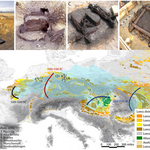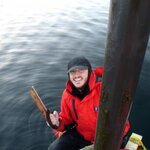Anthropology

Comet explosions did not end the prehistoric human culture, known as Clovis, in North America 13,000 years ago, according to a new paper.
Researchers from Sandia National Laboratories, Royal Holloway and 13 other universities across the United States and Europe have found evidence which rebuts the belief that a large impact or airburst caused a significant and abrupt change to the Earth's climate and terminated the Clovis culture. They argue that other explanations must be found for the apparent disappearance.
Clovis is the name archaeologists have given to the earliest well-established human…

Jared Diamond is not impressed by modern social sciences, like psychology and anthropology, because of the need to try and make claims about human nature by doing surveys or visiting a place and then framing the results through their own - not to invoke the most overused cliché of 2012 but just this once it fits - motivated reasoning.
The reaction from the social sciences and the mainstream media elites who need the social sciences to seem science-y was about what you would expect to him making his case yet again: 'shallow' and that he doesn't understand what it means 'to study human…

For decades, the consensus among psychologists has held that a group of five personality traits - openness, conscientiousness, extraversion, agreeableness, and neuroticism - are a universal feature of human psychology.
Not so, say anthropologists writing in the Journal of Personality and Social Psychology.
Studying the Tsimane, an isolated indigenous group in central Bolivia, Michael Gurven, a professor of anthropology at U.C. Santa Barbara and lead author of the paper, found they did not necessarily exhibit the five broad dimensions of personality in that five-factor model (FFM…

Prehistoric farming communities in Europe constructed water wells out of oak timbers - it seems early farmers were skilled carpenters long before metal was discovered or used for tools.
These first Central European farmers migrated from the Great Hungarian Plain approximately 7,500 years ago, and left an archaeological trail of settlements, ceramics and stone tools across the fertile regions of the continent, a record named Linear Pottery Culture (Linearbandkeramik - LBK). However, much of the lifestyle of these early settlers is still a mystery, including the climate they lived…

Modern-day gypsies, Europe's widespread Romani population, are now as diverse in language, lifestyle, and religion as any demographic but they all share a common past.
And that past started about 1,500 years ago in northwestern India, according to the first genome-wide perspective on Romani origins and demographic history. With
approximately 11 million people, the Romani represent the largest minority group in Europe, rivaling the total populations of Greece, Portugal, and Belgium. Yet they lack written historical records on their origins and dispersal. To…

Whether or not different species of early humans interbred and produced offspring of mixed ancestry - hybridization - has been the subject of recent studies but the findings are not universally accepted.
A new study of interbreeding between two species of modern-day howler monkeys in Mexico hopes to shed light on why it's so difficult to confirm instances of hybridization among primates —including early humans — by relying primarily on fossil remains.
The researchers did analyses of genetic and morphological data collected from live-captured monkeys over the past decade.…

Prehistoric artists wanted to tell a story as accurately as possible, and so they were better at portraying the walk of four-legged animals than modern man, according to a new paper.
Most quadrupeds have a similar sequence in which they move each limb as they walk, trot or run, and this sequence was studied and outlined in the early 1880s by Eadweard Muybridge.
The authors examined 1000 works of prehistoric and modern artwork ranging from cave paintings of cows and elephants to statues and paintings of horses, elephants and other quadrupeds in motion to see how well these artistic…

A new approach used to analyze genetic data to learn more about the history of populations says it can describe in detail events in recent history, over the past 2,000 years, more accurately than in the subjective texts used by people in the humanities. The computer scientists behind it demonstrate their method in two populations, the Ashkenazi Jews and the Masai people of Kenya, who represent two kinds of histories and relationships with neighboring populations - one remained isolated from surrounding groups and one had frequent cross-migration with nearby villages.
They used…

The percentage of Americans who say they are strong in their religious faith has been steady for the last four decades but a new sociology analysis claims that religious groups who have become more staunchly devout have surged while others, notably Roman Catholics, who have sought to become more liberal under Vatican II in that time, have faded in popularity.
Catholics now report the lowest proportion of strongly affiliated followers among major American religious traditions. The drop in intensity could present challenges for the Roman Catholic Church in the U.S., the study suggests, both in…

The race is on to blame everything related to ecological change on human footprints - even the past can be re-framed as anthropocenic climate change and University of Massachusetts Amherst geoscientists have shown how to do just that, by using a biomarker from human feces in a completely new way to establish the first human presence, the arrival of grazing animals and human population dynamics in a landscape.
Paleoclimatologists have long used markers in lakebed sediments, such as charcoal from humans' fires and pollen from cultivated plants, as a natural archive of environmental changes to…